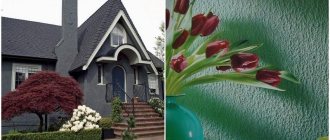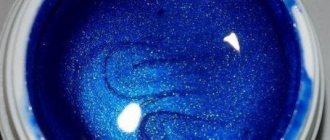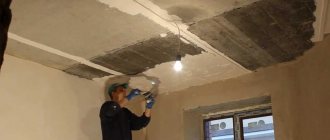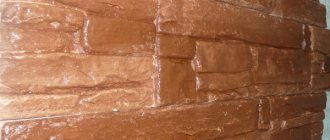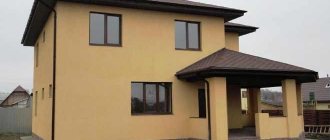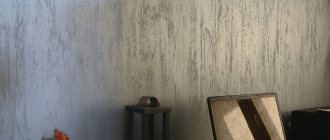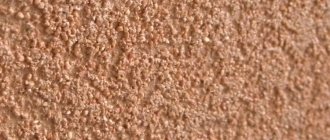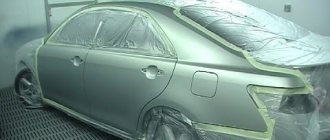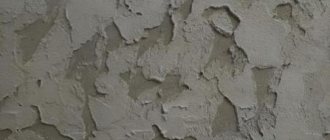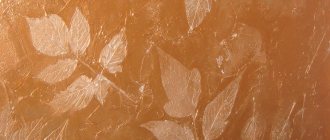Among all kinds of plaster finishes, there are compositions that date back to ancient times and are characterized by unusual properties. Smooth Moroccan plaster for its unique qualities found its way from Morocco, where craftsmen passed on its recipe and application technique from generation to generation for thousands of years. How to create a unique Moroccan decor in the interior? Start by dressing the walls.
Composition of Moroccan plaster
The main feature of this wonder is its complete waterproofness, thanks to which Moroccan decorative plaster can be used instead of tiles not only on walls, but also on the floor, on shelves, tables and other surfaces. In addition to its high resistance to water, it has remarkable strength, which is why sinks are made from it in its homeland. True, for decorative coatings these qualities alone are not enough, because a decorative coating is intended for decoration. The novelty is not in last place here either. In its decorativeness it is not inferior to the famous Venetian. Being smooth, it looks as if it has an interior, with flecks of gold in the depths.
Traditionally in Morocco, the material was used for water tanks and was highly valued for its moisture resistance and antibacterial properties.
All this is possible only thanks to the composition of the Moroccan mixture with natural ingredients:
- Quartz sand,
- hydraulic lime,
- diatomite (sedimentary rock containing the remains of shells and marine organisms - diatoms),
- clay,
- marble flour,
- natural dyes (a lot of pigment, its volume is about 1 part to 9),
Plus - a mandatory coating of a special composition, which, when reacting with lime, forms a salt moisture-proof film:
- linseed oil,
- polishing soap,
- wax.
Main characteristics
The plaster composition is distinguished by the complexity of its formulation and special application technique. The main feature is the combination of characteristics inherent in the materials used in the formulation:
- The basis is lime, which promotes the adhesion of particles. In addition, the material gives the plaster composition antiseptic properties;
- the solution is enriched with clay, quartz sand and marble flour. These fillers give the surface a special texture, reinforce the layer, and add depth to the tones;
- additives in the form of pigments saturate the material and add richness to it;
- the presence of linseed oil makes the plaster resistant to moisture. The surface is easy to wipe clean and even washable. True, such an addition increases the cost of work;
- an additive in the form of polishing soap creates a chemical reaction with the alkaline components of lime, creating a water-repellent film;
- the composition contains wax - a natural material that reliably protects against moisture penetration;
- Decorative Moroccan plaster consists of a pair of layers, visually distinguishable - preparatory and relief, differing in color. This feature adds color to the surface of the walls;
- The applied layer is polished, which gives the relief a smooth outline. From a practical point of view, this is especially important, because smooth walls are much easier to clean.
Advantages and disadvantages
The composition, which has passed the thousand-year test, has a lot of advantages.
Moroccan plaster:
- universal, can be used for both interiors and facade work,
- unique - replaces tiles, has non-standard applications,
- hygienic, environmentally friendly,
- minimalist luxurious,
- flexible, pliable in work,
- the Moroccan wall can have different shapes, the tadelakt will easily follow it,
- durable,
- resistant to open fire, can be used for finishing fireplaces,
- waterproof,
- large selection of colors used,
- easy to maintain, easy to clean,
- has a neutral odor,
- lets the walls breathe,
- not susceptible to biodestruction,
- highly decorative, has a glossy surface.
Minuses:
- difficulty of application technique for beginners,
- quite labor intensive
- high cost,
The non-classical mixture is not sufficiently resistant to scratches and other mechanical damage.
Cost and savings.
Moroccan plaster also has its disadvantages.
These include the high price of the finished plaster mortar and the difficulty of applying it to the wall. To reduce costs, you can make and apply the solution yourself. Preparing the mixture yourself may not be profitable, because enterprises have the opportunity to order ingredients directly from manufacturers, with wholesale discounts without resellers. The final price is reduced. The developer can buy composite materials at retail, often overpaying.
Before deciding to make your own mixture for decorative plaster, it is important to first accurately calculate the prices for the component materials.
Applying plaster is associated with other difficulties and is associated with the level of professionalism of the craftsmen:
- Specialists . Moroccan plaster, which is quite complex, is not learned from videos on the Internet: there are entire courses for plasterers working in this technique. Of course, the cost per square meter. the meter of their work is quite high.
- Lovers . Hiring a non-professional worker is a real savings. But even the plasterer himself does not know what will happen in the end.
- You can also apply the coating yourself But subject to sufficient experience in plastering in general. It’s worth trying on “irresponsible” walls (in the garage, basement) or pieces of drywall.
Moroccan decorative plaster has a rather complex composition. Therefore, the most organic (and common) option is to apply the purchased ready-made mixture yourself.
Tool for the job
The standard set of tools for applying special plaster - tadelakta - has been expanded:
- It will be more convenient to work with several spatulas, ranging from narrow (4 cm) to wide (up to 60 cm); for rounded surfaces, you may need rubber spatulas,
- bristle brushes,
- stainless steel trowel with rounded corners,
- polishing stone (stones must have a certain hardness on the Mohs scale from 7 to 10),
- roller,
- wooden spatula,
- sander,
- rubber roller for painting (do not use a regular roller),
- masking tape,
- containers,
- clean cloth or rags.
Features of Moroccan style
This style combines the traditions of Africa and the Mediterranean, thereby giving rise to a completely unique image. Kitchen design in Moroccan style includes the following design features:
- Quite a rich color palette. Moroccan interior is not shy about rich colors and variety of colors. Here you can find both warm and delicate pastel colors, which are used to decorate walls and floors, as well as bright, even flashy shades on decorative elements.
- The presence of constructive oriental details in the kitchen interior: decorative shutters on the windows, dome-shaped arches, mosques and niches. The most basic interior changes will help give the kitchen an oriental atmosphere - the doorway can be decorated with a pointed arch, trimmed with wood, and the door itself can be removed. It is replaced with a special barrier in the form of a curtain made of wooden beads. Window shutters are also made of wood and decorated with carvings in the form of simple geometric shapes.
- Finishing exclusively with natural materials or their high-quality imitation. The leading material is painted ceramic tiles – zelij.
- An abundance of dishes that are not hidden, but put on display.
- An abundance of patterns, both repeating and unique. The main emphasis is on ceramic tiles, however, anything can be decorated with patterns: curtains, napkins, furniture upholstery, decorative elements, etc. The patterns are usually three-color or two-color, but other color solutions are also found.
- The presence of national Arab motifs in ornaments and decor. In particular, in Moroccan cuisine you can often see mosaics made of ceramics, glass or stone.
- Decorative elements are often made by hand: patterns on tiles, forged lamps, etc.
- The classic Moroccan-style kitchen features high ceilings.
- Furniture can be quite simple in shape, but carved kitchen sets made in oriental style are just as popular. Ornaments on wood usually have geometric shapes.
- Widespread use of forged lamps. They are also most often made in a decorative style, which involves a pattern of geometric shapes.
Surface preparation
There is no need to remind you of the importance of preparatory work. Decorative plaster, originally from Morocco, is particularly demanding in terms of the quality of preparation of the base, since the coating itself is small in thickness.
The walls are cleaned, leveled, degreased and disinfected. Metal parts are insulated with special means. For walls in dry rooms, finishing putty is used.
Gypsum putty cannot be used for walls in “wet” rooms.
The walls are primed with a deeply penetrating compound. Apply it crosswise in two layers with a brush to achieve better adhesion. The first layer is dried for 3 hours. The second one is 6-8. For classic tadelakt, casein primer is used.
Where is the material used?
In the homeland of plaster - Morocco - it is used to make sinks and also cover containers for storing water, because it is not at all afraid of moisture. However, the use of tadelakt for finishing apartments, houses, cottages and public buildings is considered more traditional. The material is no less suitable for decorating shopping centers, halls for various purposes, cafes, restaurants, and hotels. Fireplaces, stoves and even floors are finished with plaster.
Tadelakt in a Moroccan interior
Application technology
Tadelakt has long been used in palaces, where it is considered a luxurious decoration; it has its own technology, which not many craftsmen in other countries are fluent in. In Europe, of course, Venetian, sand or silk plaster was more often used. Classical technology is considered complex due to the multi-layer nature and labor-intensive polishing.
Olive oil soap used to coat lime mortar reacts to form calcium stearate, a water-insoluble compound of calcium salts, stearic and other fatty acids. This substance is antibacterial.
Moroccan plaster is sold in the form of a powder, which is combined with water half an hour before use, or as a product ready for application. In the first case, the prepared solution is mixed again half an hour after mixing. In the second case, the mixture is stirred before work. The volume of added color can reach 1/10 of the total volume. Since lime mixtures become very light when dry, it would be correct to do test colors when choosing a color.
When working, you need to outline the surfaces to be treated with masking tape; remove it without waiting for the coating to dry.
Classic Moroccan plaster
- The substrate is lime plaster with coarse grain. It is applied to walls without compaction in a single layer, on the floor - in two layers. The layer thickness is slightly larger than the grain size. If lime plaster is applied to a lime base, the base should be moistened before plastering. After application, this coating takes 14-16 hours to dry.
- The main layer of tadelakt, slightly thicker than a grain, is applied with a trowel, also without compaction (some surface irregularities are possible). They give it the opportunity to set and dry a little.
- 2nd – the texture layer is applied with a thickness of no more than the grain size
- Without waiting for the solution to dry, as soon as it sets on top, they begin polishing its surface with a stone. Polishing is done with small circular movements without pressure. When shine appears and a characteristic “stone-hard” sound is heard, polishing is complete.
- Apply polishing soap with a brush, then, after waiting a little until it begins to be absorbed, begin polishing with a stone. After polishing, allow to dry for 24 hours.
Moroccan plaster is often called not the material itself, but certain application techniques. In this way, they give the interior a Moroccan style
Application by brush
Another technique for applying tadelakt allows you to create a multi-color coating.
- The first layer is applied similarly to the main one from the previous description.
- The second is applied with a brush and spatula. To do this, prepare a “palette” - small containers with a composition painted in different colors. The brush is dipped in the solution of the first color and individual strokes that lag behind each other are applied by trimming to the surface of the wall. After applying each stroke, rub it with a cross-shaped movement of the spatula.
- After applying several strokes of the same color, apply strokes of a mixture of a different color between them with a brush and spatula. You can use a brush to pick up a little solution of different colors, then the strokes will be striped, and the drawing after rubbing with a spatula will be more interesting.
- The surface is polished with stone.
- The soap composition is applied and then polished a second time.
Easy application
- The main layer (approximately 1 mm) is applied evenly, as with putty.
- To apply it, you can use a sea sponge, brush, broom or trowel. The mixture is applied by trimming. Before applying the smear, the instrument is “blotted” using tamponing movements on the bucket lid to remove excess solution. Another possibility is also possible: the most “tasty” strokes are applied at the same distance from each other, and the less “tasty” ones are applied between them.
- After allowing the solution to set and begin to dry, it is compacted with a wooden spatula, and then polished with a stone.
- The compacted polished solution is covered with soap and polished again until shiny.
Sponge application technique
To apply the mixture you will need a tight sponge with rounded edges.
- The solution is applied with a narrow spatula to the surface of the sponge (like a trowel) and, after leveling on the sponge, is transferred in a circular motion to the wall. At the same time, they try to cover the entire substrate. The sponge gives a slight relief. You can apply the material with a trowel, and then use multidirectional circular movements without pressure to give the layer a texture.
- The dried layer of ironstones is used to polish the tops of the relief using the edge of a trowel with slight pressure. The surface of the trowel must be wiped regularly so that hard lumps do not remain on it and damage the finish.
- The wax is tinted. Apply with a trowel, trying to fill the recesses of the plaster coating with wax.
- After 20-30 minutes, the wax is polished with a grinder or a drill with a disk (do this at low speeds so that the wax does not burn). After polishing mechanically, you can polish it manually.
Moroccan with cracks
The coating is very similar to the Venetian. By choosing the color, you can achieve the effect of noble marble. In this case, a primer with quartz sand is not used.
- The first layer is applied sparingly on the strip, crosswise without gaps.
- The second layer covers approximately 95% of the surface (some areas are left uncovered).
- Using a sharp instrument, cracks are scratched into the undried layer. Wider lines are for the main body of the crack; thin cracks are drawn with a sharper object.
- After drying, the surface is treated with sandpaper. No. 180.
- A layer of varnish is applied with a spatula in order to fill cracks and micropores (the absorbency of the surface decreases. Dust that cannot be completely eliminated is saturated with the varnish and becomes part of it. Excess varnish is also removed with a spatula.
- After the varnish has dried, wax with the addition of mother-of-pearl is applied to the surface.
- Final polishing is done mechanically with a wool disc.
Imitation acrylic plaster
Natural lime composition is very expensive. It can be replaced with an acrylic-based mixture. The mixture is tinted before use, not forgetting that the tone fades when it dries. You can add several pigments. To obtain a natural natural color, just a little black color is added.
- The first layer is applied with an acrylic mixture that does not contain marble chips and quartz filler. You need to apply the layer evenly, but you can’t do it perfectly, since the unevenness will be leveled out after applying the second layer.
- The second layer is applied after about an hour with light, short cross movements of the spatula. This creates a low-relief texture with many small differences.
- After an hour, gold varnish is applied with a spatula using arc movements “on the scrape”. If desired, gold varnish can be diluted with silver.
The first layer is applied approximately 1 mm thick, evenly, as when puttying.
Pros and cons of the material
In addition, the plaster composition has the following advantages:
- Compared to the well-known wallpaper, plaster applied to the wall does not create seam areas, creates a glossy surface and is easy to decorate;
- the finishing material is not flammable and does not support combustion;
- resistance to high temperatures allows the use of plaster composition when finishing fireplaces;
- the mixture consists of environmentally friendly components; harmful microorganisms do not multiply on the surface of the walls;
- the material withstands direct contact with water;
- the walls retain the ability to “breathe”;
- a huge number of color shades allows you to use the finishing material in the design of any style solutions.
It is fair to note that Moroccan decorative plaster has certain disadvantages:
- high cost of the material, the need for careful preparation of the walls before applying it;
- insufficient resistance to mechanical damage. Scratches remain on the glossy surface;
- As a disadvantage, we can note the difficulties that arise when applying it yourself. Every developer can buy everything he needs and plaster the wall, but what he gets in the end remains unpredictable. For this reason, the job requires certain skills.
This finishing material has excellent quality - it is absolutely not afraid of exposure to water, which makes it possible to use it in rooms with high humidity.
Moroccan plaster in the interior photo
A true classic coating - tadelakt - requires skill and experience in application. This type of coating is expensive and the work takes a long time. But you can paint the walls of your home with beautiful and durable Moroccan plaster with your own hands. This can be done on a budget and with good results.
How to do it yourself?
The process of plastering walls is considered fascinating, interesting and at the same time quite difficult to perform. The fact is that applying decorative plaster is a certain creativity. To understand whether you can do such work with your own hands and what results you will get, it is recommended to test your strength on a small piece of plasterboard material.
It is likely that the result will satisfy you, and the work itself will not only bring pleasure, but will also save you a decent amount of money.
Moroccan tiles in the kitchen
The uniqueness of the Moroccan style for kitchen decoration is given by special ceramic tiles with a pattern, made using the ancient technique of Arab masters - zelij. Most often it is small in size, distinguished by a glazed surface and bright ornaments. It may fit entirely on a tile, however, in the same way, each tile often contains only part of the design. Then a full-fledged pattern consists of four tiles. The ornament can be in the shape of a square, rhombus or polyhedron.
If desired, you can lay out a mosaic in the kitchen in a Moroccan style made of glass or stone. Moreover, mosaic coating is used not only to decorate the backsplash and walls in a Moroccan kitchen - it is also used to decorate countertops.
Selection and arrangement of furniture
Kitchen furniture in Moroccan style is selected with carved elements. Also, the kitchen set can have smooth curved lines and pointed patterns. A countertop with Moroccan tiles made of stone or ceramics will give a special oriental atmosphere to the kitchen interior.
A special coziness is given to the room by using the effect of antiquity - furniture can be purchased with patina or you can cover the wood with this substance yourself.
Decor and accessories
The main decor for a Moroccan-style kitchen is ceramic tiles, which cover the walls, backsplash and even countertops. Sometimes tile mosaics are laid on the floor.
Clay or glassware with Arabic designs are used as additional decoration. You can also furnish the kitchen with a variety of African figurines.
If the floor is finished in one color, you can put a bright Arabic carpet on the tiles, parquet or stone, the main colors of which echo the curtains or upholstery. Cotton napkins with an oriental pattern or a colorful tablecloth are often placed on the table.
